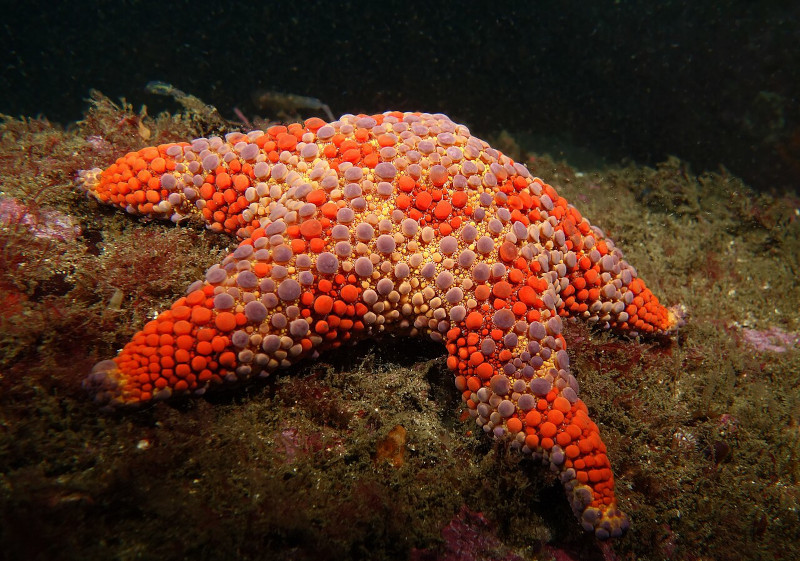
Firebrick Starfish Facts
- This highly distinctive denizen of the depths most frequently goes by the descriptive, as well as colorful, common name of the Firebrick Starfish. Somewhat uncommonly, the amazing creature presently has no other widely accepted general title.
- Within the circles populated by scientists, however, it’s perhaps better known by its technical moniker. Unfortunately, that’s a difficult one for the layperson to pronounce. That’s because it bears the cumbersome formal tag of Asterodiscides truncatus.
- The intriguing invertebrate received that specific appellation due to the efforts of Hedley L. Coleman. That respected Australian zoologist achieved the first recognition of the creature as a separate and distinct species. He managed that feat in 1911.
- Thankfully, the remarkable Firebrick Starfish appears to be maintaining a population base that’s both stable and sufficient. That pleasant trend also seems to hold true across its entire range. The IUCN therefore currently has no listing for the animal.
- It nevertheless should be considered to be facing the same potential threats to its existence as other species. Most of these perils stem from the actions of mankind. They include the related dangers of habitat loss and the ongoing effects of climate change.
Related Articles
Firebrick Starfish Physical Description
The astounding Firebrick Starfish generally captures the interest of anyone who encounters one of the marine marvels. Yet, this fascination and appreciation rarely occurs due to it pure size. That’s true since, compared to some of its kin, it’s somewhat diminutive.
Following the pattern established by those numerous relatives, the Echinoderm additionally displays no outward sign of sexual dimorphism. Without the presence of this physiological trait, distinguishing the genders visually becomes impossible for the casual observer.
Both sexes therefore present the same external characteristics for the world to appreciate. Mature adults attain an average body width only measuring approximately 5 in (12.7 cm). Nature, though, manages to pack quite a lot into this surprisingly small package.
As remains common among members of its specific Phylum, it also evolved multiple tube feet on the underside of the body. These tiny appendages further possess suckers attached to their tips. Its small mouth also appears at the center of the underside of the body.
Yet, it’s the arms of the fabulous Firebrick Starfish that garner the most appreciation, though. Like most of its many known kindred, it has five of these. Incredibly, however, each of these structures has a completely random collection of bumps, masses, and lumps!
In color, these present a dazzling array of hues. Those consist mainly of shades of bright purple, orange, and yellow. Even the ends of the arms aren’t exempt from such features, though. On the tip of each, an extra-large, bulbous blob of varying colors also shows.
- Kingdom: Animalia
- Phylum: Echinodermata
- Class: Asteroidea
- Order: Valvatida
- Family: Asteroidiscididae
- Genus: Asteroidiscides
- Species: A. truncatus
Firebrick Starfish Distribution, Habitat, and Ecology
The gorgeous Firebrick Starfish developed as native to a comparatively small expanse of the many marine regions of the earth. Given its nature, though, the location of that zone of habitation likely won’t surprise many people. It evolved as native to the waters off Australia.
Even within this restricted range, however, it only inhabits specific sections of the greater overall area. These also represent scattered areas. The animal appears along the east and south coasts, the western part of the Norfolk Ridge, and around the Kermadec Islands.
Nature did provide the colorful marine wonder with one evolutionary assist, though. That’s because it displays a moderate degree of flexibility regarding its choice of habitat. This does extend its habitation possibilities inside an otherwise quite limited territorial range.
Along the southern shoreline of the continent, it lives at respectable depths. There, specimens appear in waters up to 400 ft (122 m). That zone’s also mainly rocky in nature. Yet, off New South Wales, it dwells on or near shallow reefs found within the subtidal zone.
But, wherever it makes its home, the awesome Firebrick Starfish follows established patterns of behavior. The species developed as carnivorous in terms of diet. Its preys exclusively on various sponges, and related creatures. Usually, this occurs in kelp forests, for camouflage.
Otherwise, researchers still lack detailed information regarding much of the specific biology of this invertebrate. Its own predators comprise the same group as others of its kind. These principally consist of various fish, crabs, and sea turtles. A typical lifespan is still unknown.
Species Sharing Its Range
Check out our other articles on 7 Magnificent West Coast Marvels, Vietnamese Mossy Frog, Komodo Island, Orange Jewelweed, East African Lowland Honey Bee, Mangrove Monitor
